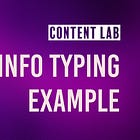📹 Video companion post - Watch the full walkthrough above to see this system in action.
After taking Precision Content's course on Information Typing, I realized my study abroad notes were a mess.
Everything was jumbled together in long paragraphs that made sense to me but would be terrible for AI systems—and honestly, not great for humans either.
I shared some of this new approach in my last post about AI-ready content and during last week's webinar with Rob Hanna, but this video goes deeper into the actual system I'm building.
The goal is simple: create knowledge that works for both my future self and AI assistants. If I can make information easier for humans to scan and understand, it automatically becomes better for AI too.
Paid subscribers can see entry showing the full Information Typing example in my content lab.
How I'm restructuring everything
Here's a typical paragraph from my Krakus Mound notes:
"A visit to Krakus mound shows students a space few tourists experience and that is beloved by the locals, also providing an opportunity to enjoy some green space and bond as a group. I usually schedule this impromptu … when it feels right and the weather is good."
This mixes the educational rationale, the scheduling process, and practical tips all together. It reads fine, but finding specific information quickly? Not so much.
The process is straightforward:
Break content into chunks - Separate each distinct piece of information
Label by cognitive purpose - What does the user need to do with this chunk?
Apply Information Types - Reference, Concept, Principle, Process, or Task
Connect related items - Link locations, activities, and resources together
For example, that messy Krakus Mound paragraph became:
<rationale type="concept">
A visit to Krakus mound shows students a space few tourists experience...
</rationale>
<process type="process">
I usually schedule this impromptu when it feels right and the weather is good...
</process>
Now the AI (and humans) can immediately distinguish between the "why" and the "how."
The AnyType knowledge graph setup
I'm using AnyType because it forces you to identify what type everything is—person, place, activity, restaurant. This creates a knowledge graph where the AI knows that all restaurants are places, but not all places are restaurants.
The platform lets me:
Tag everything by type (restaurant, historical site, etc.)
Link related locations and activities
See connections visually in a graph view
Build templates for consistent information structure
Why this approach works
Good structure serves both humans and AI. When content is organized around cognitive function rather than just randomly, everyone benefits.
I can scan for specific information types quickly. The AI can distinguish between facts and guidance without guessing. Future facilitators can understand the system immediately.
This isn't just about study abroad notes. It's about creating knowledge that scales. The same principles apply to any domain where you need structured information: technical documentation, course materials, research documentation, professional knowledge bases.
The goal is building AI assistants that actually understand the purpose of different information, not just keywords. When you structure content around how minds—human and artificial—naturally process information, you get better results for everyone.
What's next
I'm still building this system out. The knowledge graph is pretty sparse right now, but you can already see how the connections work. Each location will eventually have the same information structure: description, rationale, process, guidance, and specific experiences.
The real test will be when I ask the AI to generate student communications or help with planning decisions. Instead of feeding it random paragraphs, it'll have access to clearly labeled, purposeful content.
What questions do you have about transforming your own knowledge into AI-ready content? Share your thoughts in the comments below.











